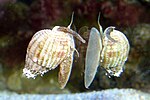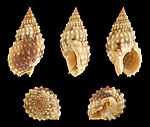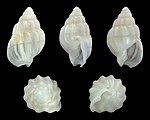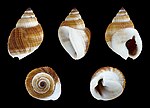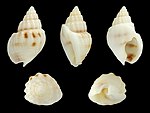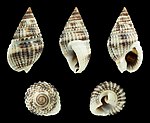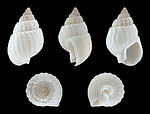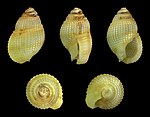
A | B | C | D | E | F | G | H | CH | I | J | K | L | M | N | O | P | Q | R | S | T | U | V | W | X | Y | Z | 0 | 1 | 2 | 3 | 4 | 5 | 6 | 7 | 8 | 9
| Nassarius | |
|---|---|

| |
| Shell of Nassarius arcularia | |
| Scientific classification | |
| Domain: | Eukaryota |
| Kingdom: | Animalia |
| Phylum: | Mollusca |
| Class: | Gastropoda |
| Subclass: | Caenogastropoda |
| Order: | Neogastropoda |
| Family: | Nassariidae |
| Subfamily: | Nassariinae |
| Genus: | Nassarius Dumeril, 1806 |
| Type species | |
| Buccinum arcularia Linnaeus, 1758 | |
| Species | |
|
See text | |
| Synonyms[1] | |
| |
Nassarius, common name nassa mud snails (USA) or dog whelks (UK), is a genus of minute to medium-sized sea snails, marine gastropod molluscs in the family Nassariidae.[1] They are scavengers.
Etymology
The name is derived from the Latin word "nassa", meaning a wickerbasket with a narrow neck, for catching fish. Nassarius would then mean "someone who uses such a wickerbasket for catching fish".
Ecology
Distribution and habitat
Species within this genus are found worldwide. These snails usually live on mud flats or sand flats, intertidally or subtidally.
Life habits
Most Nassarius species are very active scavengers, feeding on crabs and carrion as dead fish, etc. They often burrow into marine substrates and then wait with only their siphon protruding, until they smell nearby food.
Shell description
The shells of species in this genus have a relatively high cyrtoconoid (approaching a conical shape but with convex sides) spire and a siphonal notch.
(Described as Aciculina) The shell is turreted, polished, smooth or longitudinally plicate. The inner lip shows the callus sharp, straight, defined. The outer lip is produced in the middle, variced externally.[2]
(Described as Nassa) The eyes are situated on the middle of the tentacles. The lingual teeth are arched and pectinated. The uncini show a basal tooth. The foot is large, expanded and bifurcate at its posterior extremity.
The operculum is ovate, the margin serrated or entire.
The shell is ovate and ventricose. The body whorl is variously sculptured. The aperture is ovate, with a short reflected truncated anterior canal. The inner lip is smooth, often widely spread over with enamel, with a posterior callosity or blunt dentiform plait. The outer lip is dentated, internally crenulated.[2]
Anatomy
The animal has a long siphon.
Human use
Archeology
Several beads made from Nassarius gibbosulus shells are thought to be the earliest known forms of personal adornment, or even jewelry. Two shell beads found in Skhul Cave on the slopes of Mount Carmel, Israel, are thought to be 100,000 years old, whilst another found at Oued Djebbana, Algeria, is believed to be 90,000 years old. A further group of pierced shells, some with red ochre, has been recovered from the Aterian levels at the Taforalt site in Morocco; these Nassarius gibbosulus beads have been securely dated to about 82,000 years ago.[3]
All these examples predate several 75,000-year-old Nassarius kraussianus beads which were found at Blombos Cave, South Africa (including some colored with red ochre). These beads had previously been thought to be the oldest examples of jewelry.[4]
From A.D. 1130 to 1275, shell beads were manufactured by the inhabitants of the Exhausted Cave near the Clear Creek Ruins. A Southern Sinagua site in Verde Valley, Arizona where "shell played a major role in the economic system of this culture."[5]
Modern uses
Nassarius vibex is a species which is often selected for marine aquaria. It is often confused with Nassarius obsoletus, a cooler water snail less suited to tropical marine aquarium temperatures. In aquaria, the Nassarius is considered nearly indispensable for keeping sand beds clean and healthy, as these snails tend to burrow and plow through the upper layer in a conch-like fashion, keeping algae and detritus from building up visibly on the surface.
The shells of various species of Nassarius are popular with shell collectors, and are sometimes used in jewelry and other forms of decoration.
Taxonomy
The genus Nassarius has traditionally been subdivided into several subgenera, based on differences in shell morphology, especially the sculpture: Aciculina, Alectrion, Allanassa, Nassodonta, Niotha, Plicarcularia, Profundinassa, Pygmaeonassa, Telasco, and Zeuxis. However, this division is difficult to define, resulting in much confusion. Even phylogenetic analysis shows that the division into these subgenera appears to be uncertain and unreliable. There seem to be two groups within the genus Nassarius with the closest relationship between the subgenera Zeuxis and Telasco. Even the species within the subgenus Plicarcularia do not belong to a single clade. In the end, the molecular phylogeny did not match the previous morphological phylogeny.[6]
Gallery
-
Nassarius scaldisianus
-
Nassarius semistriatus
-
Nassarius semistriatus
-
Nassarius (Alectrion) glans glans
-
Nassarius (Alectrion) papillosus
-
Nassarius (Hima) fuscolineatus
-
Nassarius (Hima) kochianus
-
Nassarius (Nassarius) arcularia
-
Nassarius (Nassarius) coronatus
-
Nassarius (Nassarius) crenoliratus
-
Nassarius (Nassarius) graphiterus
-
Nassarius (Nassarius) gregarius
-
Nassarius (Niotha) albescens albescens
-
Nassarius (Niotha) conoidalis (fossil)
-
Nassarius (Niotha) conoidalis conoidalis
-
Nassarius (Niotha) coronulus
-
Nassarius (Niotha) distortus (Smooth form)
-
Nassarius (Niotha) ecstilbus
-
Nassarius (Niotha) gruneri
-
Nassarius (Niotha) jacksonianus
-
Nassarius (Niotha) livescens
-
Nassarius (Niotha) nodiferus
-
Nassarius (Niotha) quadrasi
-
Nassarius (Niotha) stolatus
-
Nassarius (Niotha) tiarula
-
Nassarius (Plicarcularia) bellulus
-
Nassarius (Plicarcularia) bimaculosus
-
Nassarius (Plicarcularia) elegantissimus
-
Nassarius (Plicarcularia) fissilabris
-
Nassarius (Plicarcularia) pullus
-
Nassarius (Telasco) limnaeiformis
-
Nassarius (Telasco) multipunctatus
-
Nassarius (Telasco) reeveanus f. zonalis
-
Nassarius (Uzita) reticosus
-
Nassarius (Zeuxis) celebensis
-
Nassarius (Zeuxis) dorsatus
-
Nassarius (Zeuxis) margaritifer
-
Nassarius (Zeuxis) niveus
-
Nassarius (Zeuxis) ocellatus
-
Nassarius (Zeuxis) olivaceus
-
Nassarius (Zeuxis) variciferus
Species
In the course of time, more than 1,000 names have been allocated to species in the genus Nassarius, most of which have become synonyms.
The following species are accepted names according to the World Register of Marine Species (WoRMS):[1]
- Nassarius absconditus Gili, 2015
- Nassarius abyssicolus (A. Adams, 1852)
- Nassarius acteon MacNeil, 1960
- Nassarius acuminatus (Marrat, 1880)
- Nassarius acuticostus (Montrouzier in Souverbie & Montrouzier, 1864)
- Nassarius acutus (Say, 1822)
- † Nassarius adae (Boettger, 1902)
- Nassarius adami Arthur & Fernandes, 1989
- Nassarius agapetus (Watson, 1882)
- †Nassarius agatensis (Bellardi, 1882)
- Nassarius alabasteroides Kool, 2009
- Nassarius albescens (Dunker, 1846)
- Nassarius albinus (Thiele, 1930)
- Nassarius albomaculatus Rehder, 1980
- †Nassarius alfuricus (Fischer in Wanner, 1927)
- Nassarius algidus (Reeve, 1853)
- † Nassarius amycliformis (Shuto, 1969)
- Nassarius angolensis (Odhner, 1923)
- † Nassarius angulatus (Brocchi, 1814)
- Nassarius anguliferus (A. Adams, 1852)
- † Nassarius anomalus (Harmer, 1914)
- † Nassarius antiquus (Bellardi, 1882)
- Nassarius aoteanus Finlay, 1926
- Nassarius arcadioi Rolán & Hernández, 2005
- Nassarius arcularia (Linnaeus, 1758)
- Nassarius arcus Cernohorsky, 1991
- Nassarius arewarensis Nerurkar, Shimpi & Apte, 2020
- Nassarius argenteus (Marrat, 1877)
- † Nassarius asperulus (Brocchi, 1814)
- Nassarius atlantideus Adam & Knudsen, 1984
- † Nassarius attiguus (Bellardi, 1882)
- Nassarius babylonicus (Watson, 1882)
- † Nassarius badensis (Hörnes, 1852)
- Nassarius bailyi (Pilsbry & Lowe, 1932)
- † Nassarius banaticus (Boettger, 1902)
- † Nassarius bantamensis Oostingh, 1933
- † Nassarius barbarossai Landau, Harzhauser, İslamoğlu & Silva, 2013
- Nassarius barsdelli Ladd, 1976
- † Nassarius beberkirianus (K. Martin & Icke, 1906)
- Nassarius bellulus (A. Adams, 1852)
- Nassarius bellus (Marrat, 1877)
- Nassarius berniceae Willan & Beechey, 2015
- † Nassarius beureumensis Oostingh, 1933
- Nassarius bicallosus (E.A. Smith, 1876)
- Nassarius biendongensis Kool, 2003
- Nassarius bifarius W. Baird, 1873
- Nassarius bimaculosus (A. Adams, 1852)
- † Nassarius bolangoi (Ladd, 1976)
- † Nassarius bonellii (Sismonda, 1847)
- Nassarius boucheti Kool, 2004
- Nassarius bourbonensis Kool, 2015
- † Nassarius brebioni Van Dingenen, Ceulemans, Landau & C. M. Silva, 2015
- Nassarius brunneostomus (Stearns, 1893)
- Nassarius bruuni Adam & Knudsen, 1984
- Nassarius cadeei Kool, 2006
- Nassarius caelatus (A. Adams, 1852)
- Nassarius caelolineatus Nesbitt & Pitt, 1986
- Nassarius callospira (A. Adams, 1852)
- † Nassarius caloosaensis (Dall, 1890)
- Nassarius camelus (von Martens, 1897)
- Nassarius candei (d'Orbigny, 1847)
- Nassarius candens (Hinds, 1844)
- † Nassarius cantauranus Landau, 2010
- Nassarius capensis (Dunker, 1846)
- Nassarius capillaris (Watson, 1882)
- Nassarius castus (Gould, 1835)
- Nassarius catallus (Dall, 1908)[7]
- † Nassarius cautleyi (d'Archiac & Haime)
- Nassarius celebensis (Schepman, 1907)
- † Nassarius cerithiformis (Hilber, 1879)
- Nassarius cernohorskyi Kool, 2005
- Nassarius cerritensis (Arnold, 1903)
- Nassarius chibi (Habe, 1960)
- † Nassarius chiereghinii (Bellardi, 1882)
- Nassarius cinctellus (Gould, 1850)
- Nassarius cinctellus (A. Adams, 1852) (invalid as a junior homonym, but temporarily retained)
- Nassarius cinnamomeus (A. Adams, 1852)
- Nassarius circumcinctus (Adams A., 1852)
- Nassarius clarus (Marrat, 1877)
- † Nassarius clathratus (Born, 1778)
- Nassarius collarius (C. B. Adams, 1852)
- † Nassarius coloratus (Eichwald, 1830)
- † Nassarius columbinus Van Dingenen, Ceulemans, Landau & C. M. Silva, 2015
- † Nassarius companyoi (Fontannes, 1879)
- Nassarius compertus Fernández-Garcés, Espinosa & Rolán, 1990
- Nassarius comptus (Marrat, 1880)
- Nassarius comptus polita (Marrat, 1880)
- Nassarius concinnus (Powys, 1835)
- Nassarius congrua (Yokoyama, 1926)
- Nassarius conoidalis (Deshayes, 1832)
- Nassarius consensus (Ravenel, 1861) - striate nassa
- Nassarius coppingeri (E.A. Smith, 1881)
- Nassarius coriolis Kool, 2009
- Nassarius coronatus (Bruguière, 1789)
- Nassarius coronulus (A. Adams, 1852)
- † Nassarius corrugatus (Brocchi, 1814)
- † Nassarius crassigranosus (Tate, 1888)
- † Nassarius crassiusculus (Nyst, 1845)
- † Nassarius crebresulcatus (Bellardi, 1882)
- Nassarius crebricostatus (Schepman, 1911)
- Nassarius crematus (Hinds, 1844)
- Nassarius crenoliratus (A. Adams, 1852)
- Nassarius crenulatus (Lamarck, 1816) (nomen dubium)
- † Nassarius daciae (Hoernes & Auinger, 1882)
- Nassarius dakarensis (Fischer-Piette & Nicklès, 1946)
- Nassarius dekkeri Kool, 2001
- Nassarius delicatus (A. Adams, 1852)
- Nassarius delosi (Woodring, 1946)
- † Nassarius demissus (Yokoyama, 1923)
- † Nassarius denselineatus (Nagao, 1928)
- Nassarius dentifer (Powys, 1835)
- Nassarius deshayesianus (Issel, 1866)
- Nassarius deshayesii (Hombron & Jacquinot, 1848)
- Nassarius desmoulioides (G.B. Sowerby III, 1903)
- Nassarius dijki (K. Martin, 1895)
- Nassarius dilutus (E.A. Smith, 1899)
- Nassarius dimorphoides Oostingh, 1935
- Nassarius disparilis (E.A. Smith, 1903)
- Nassarius distortus (A. Adams, 1852)
- † Nassarius doliolum (Eichwald, 1830)
- Nassarius dorri Wattebled, 1886[8]
- Nassarius dorsatus (Röding, 1798)
- Nassarius dorsuosus (A. Adams, 1852)
- † Nassarius dujardini (Deshayes, 1844)
- Nassarius echinatus (A. Adams, 1852)
- Nassarius ecstilbus (Melvill & Standen, 1896)
- † Nassarius edlaueri (Beer-Bistrický, 1958)
- † Nassarius eichwaldi (Friedberg, 1911)
- † Nassarius elabratus (Doderlein, 1862)
- Nassarius elegantissimus Shuto, 1969
- Nassarius emilyae Moolenbeek & Dekker, 1994[9]
- † Nassarius eniwetokensis Ladd, 1977
- Nassarius enzoi Bozzetti, 2007
- † Nassarius erentoezae Landau, Harzhauser, İslamoğlu & Silva, 2013
- † Nassarius erunalae Landau, Harzhauser, İslamoğlu & Silva, 2013
- Nassarius euglyptus (G. B. Sowerby III, 1914)
- Nassarius eusulcatus (Sowerby, 1902)
- Nassarius excellens (Kuroda & Habe, 1961)
- Nassarius exilis (Powys, 1835)
- Nassarius eximius (H. Adams, 1872)
- Nassarius exsarcus (Dall, 1908)
- † Nassarius exspectatus (Bałuk, 1997)
- † Nassarius exstincteliratus (Fischer in Wanner, 1927)
- Nassarius exulatus (E.A. Smith, 1911)
- † Nassarius falconeri (d'Archiac & Haime, 1854)
- Nassarius fenistratus (Marratt, 1877)
- † Nassarius fennemai Oostingh, 1939 Zdroj:https://en.wikipedia.org?pojem=Nassarius
Text je dostupný za podmienok Creative Commons Attribution/Share-Alike License 3.0 Unported; prípadne za ďalších podmienok. Podrobnejšie informácie nájdete na stránke Podmienky použitia.
Antropológia
Aplikované vedy
Bibliometria
Dejiny vedy
Encyklopédie
Filozofia vedy
Forenzné vedy
Humanitné vedy
Knižničná veda
Kryogenika
Kryptológia
Kulturológia
Literárna veda
Medzidisciplinárne oblasti
Metódy kvantitatívnej analýzy
Metavedy
Metodika
Text je dostupný za podmienok Creative
Commons Attribution/Share-Alike License 3.0 Unported; prípadne za ďalších
podmienok.
Podrobnejšie informácie nájdete na stránke Podmienky
použitia.
www.astronomia.sk | www.biologia.sk | www.botanika.sk | www.dejiny.sk | www.economy.sk | www.elektrotechnika.sk | www.estetika.sk | www.farmakologia.sk | www.filozofia.sk | Fyzika | www.futurologia.sk | www.genetika.sk | www.chemia.sk | www.lingvistika.sk | www.politologia.sk | www.psychologia.sk | www.sexuologia.sk | www.sociologia.sk | www.veda.sk I www.zoologia.sk

